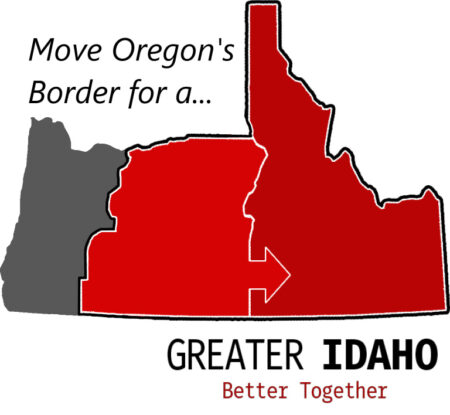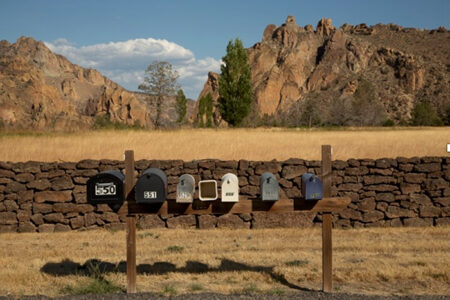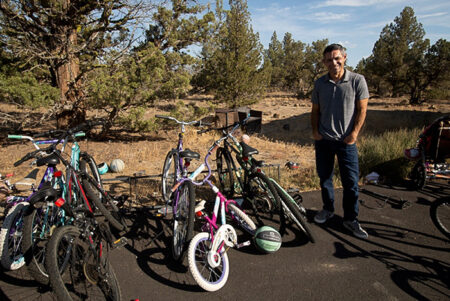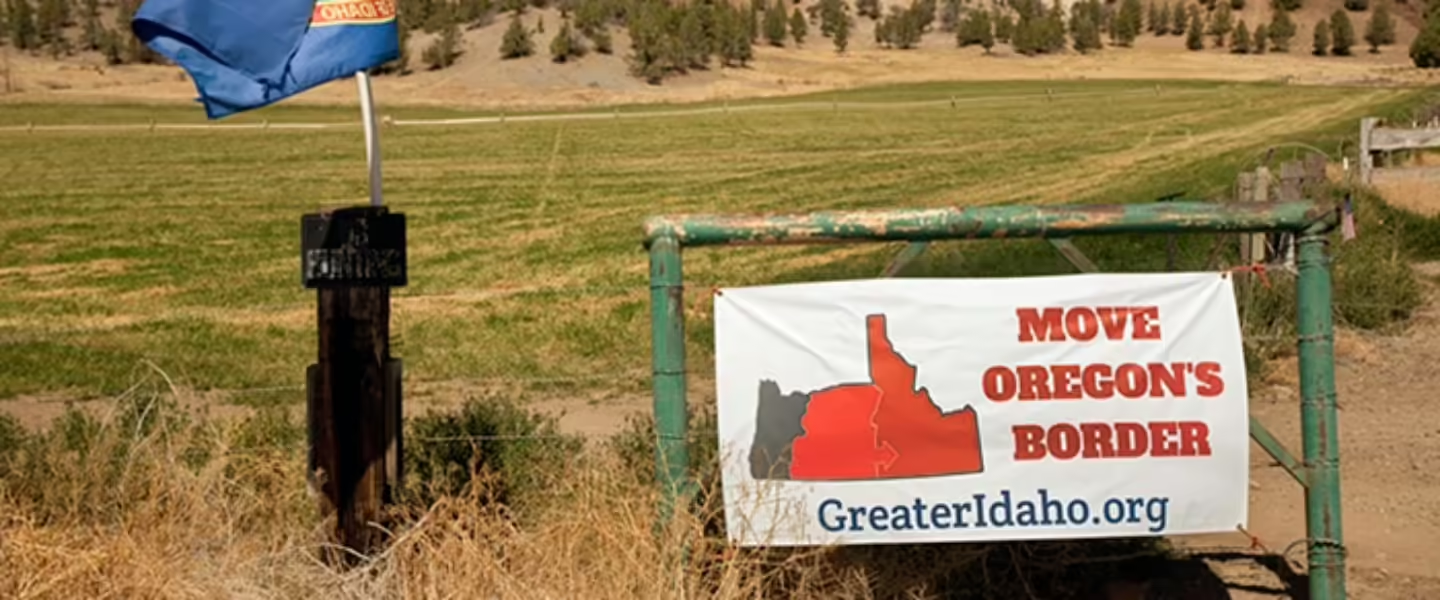Rural and Urban America Find a Battleground in the Greater Idaho Movement
Thirteen rural counties in eastern Oregon contemplate joining Idaho in the hope of getting state representation more to their liking.
|
Listen To This Story
|
Nothing symbolizes the polarization that has gripped America more clearly than the culturally and politically bifurcated state of Oregon. More than four-fifths of the population enjoys a high-tech, urban culture in the western part of the state — which is separated geographically from the ranchers and farmers in the state’s eastern counties by the Cascade Mountains. Oregonians who live to the east of the Cascades represent less than one-tenth of the state’s population, but occupy two-thirds of its land mass. International photojournalist Tom Haley spent several weeks traveling through the state to investigate the Greater Idaho Movement, which seeks to merge the counties of eastern Oregon into the adjacent state of Idaho — a project that has become a conservative vehicle for exacerbating already volatile political tensions. This is his report.
A growing segment of politically conservative, rural, and mostly white eastern Oregonians are frustrated. They claim that they are ignored by a state government that neither understands nor agrees with them and which they are convinced is hell-bent on teaching a younger generation to “hate Americans.” They also accuse the state Legislature of diverting tax dollars toward programs that violate their conscience. The solution, they are convinced, is to secede from Oregon and become part of neighboring Idaho.
So far, 13 of Oregon’s 14 eastern counties have held referendums demanding that county administrators convene public meetings to discuss the impact that moving the border would have on taxes, salaries, social security, and property values. The county-level referendums are not legally binding, and reconfiguring the state borders is not likely, since it would require agreement from both Oregon and Idaho’s state legislatures, not to mention the US Congress. While it’s not likely to succeed, the secessionist sentiment has coalesced into the Greater Idaho movement, which is currently disrupting legislatures in both Oregon and Idaho.
The Cascade Mountain range, running from the north to the south, marks a political divide between liberal western Oregon and more conservative eastern Oregon. Most of Oregon’s major cities and universities are located in the Willamette Valley, west of the Cascades. Nearly 87 percent of Oregon’s population resides in its western counties, while the eastern counties, which account for only 9 percent of the state’s population, account for nearly two-thirds of Oregon’s land mass. More than half of all Oregonians live in the Portland metro area, which is much more culturally diverse and ethnically mixed than the eastern counties. Since 1988, Oregon voters statewide have consistently favored Democratic candidates for most major elected positions, including the US presidency.
I grew up in Salem, the state capital of Oregon, in the center of the Willamette Valley, and I came to know the people on both sides of the Cascade Mountains. Eastern Oregon has always been a special place for me. I’m drawn to its geography and history, and its reverence for its pioneering traditions. I consider myself a liberal, yet I can understand eastern Oregonians’ feelings of resentment over not having a voice in a state Legislature that makes policy decisions that affect their daily lives. Indeed, the stark divide between east and west made me question the validity of majority rule as the only criterion to determine which policies are implemented.
Oregon, which became a state in 1859, a year before the start of the Civil War, originally served as a safe haven for Americans fleeing the mounting conflict between southern slave-holding states and the northern states increasingly bent on abolishing slavery. Today, less than 2 percent of the state’s population is African American. Idaho, which has less than half of Oregon’s population, did not become a state until 1890.
In contrast to the lush forests of western Oregon’s coastal range, eastern Oregon is characterized by the high plains desert culture of the American West, with its ranchers, independent homesteaders, and wheat farmers who espouse a rugged individualism they see as rooted in the region’s pioneering past. When it comes to geography and natural environment, there’s no question that eastern Oregon has a lot more in common with Idaho than it does with western Oregon. That goes for its conservative politics as well.
In returning to this deeply divided region, I wanted to explore whether a modern, pluralistic society can tolerate a cultural minority whose “traditional” values do not align with the views of the majority. I thought the special character of eastern Oregon, as I remembered it, would be a good place to start. At a time of an increasingly fractured national identity, the Greater Idaho movement seemed to embody a deepening political divide at the grassroots level.

County Commissioners Meeting
Malheur County in the southeastern corner of Oregon was settled by miners and cattlemen in the 1860s. It’s the second-largest county in the state. The population density today is only two persons per square mile. In 2021, county residents voted 54 percent in favor of requiring their county commissioners to hold meetings to discuss the feasibility and economic impact of becoming part of Idaho.
Last September, the Malheur County commissioners met in Vale to discuss the pros and cons of changing the border. Around 15 people — Republicans, Democrats, and a few independents — attended the meeting, which began with the pledge of allegiance to the flag: “One nation under God.” There followed a solemn moment of silence in memory of the 9/11 attack on the World Trade Center.
Dan Joyce, the county judge, chaired the meeting. When people were called upon to speak, they introduced themselves with a brief personal history, including how many generations back their families had settled in the area.
It quickly became clear that there would be no consensus on the proposal to detach the eastern counties from Oregon and join them to Idaho. Bob Wheatly, representing the pro-secessionist Greater Idaho movement, noted that most citizens lack the expertise needed to make an informed decision on such a complex issue, hence the movement’s educational campaign.
Blu Fortner, representing the movement’s opponents, said that his group, “Greater Oregon,” preferred to celebrate the uniqueness of living in Oregon. “You folks are not being honest,” he said. “Your website implies that the people voted to move the border, that’s not true. … They voted to discuss the issue!”
Fortner added that members of Greater Oregon are also frustrated by what they feel is a lack of representation in the state Legislature, but they think that the secessionist position is unrealistic: “It’s not going to happen!” Which is why his group is petitioning the county to end the meetings.
Mike McCarter, the president of the Greater Idaho movement, was attending the meeting via Zoom. Fortner asked him, “When the Idaho and Oregon legislatures aren’t willing to consider the issue any further, are you guys willing to work together with Greater Oregon to leverage our collective voice so that folks in Portland and Salem will listen to us?”
“We’ll work with anybody to try to help resolve the problems,” McCarter responded. “Greater Idaho is about traditional values — faith, family, freedom and self-sufficiency; less government regulation, less taxes, and let’s not have the green movement pushed down our throats.”
A middle-aged woman, who owns a farm and favors moving the border, gave her reasons to support secession: “We see the Snake River from our front window. Idaho is on the other side. … We have worked hard. … We built our dream house here. We don’t want to move, but we’re going to have to when my husband retires. … We don’t want to have to sell off part of the farm to pay a death tax to the state.”
Another speaker, Brent Grasty, addressed his concerns directly to McCarter: “Mike, this movement just rubs a lot of Oregonians the wrong way. After several meetings you folks still have not addressed the list of questions that would help us determine whether or not this move would be a good thing. Also, I’m struggling with the idea of separating ourselves from the state; we’re all neighbors, we all live together, we’ve seen other communities tear themselves apart. … We can’t let this happen here! We’ve got to come together and talk about the solutions to the problem.”
He continued, “I also want to say that I’m struggling with the idea that everything that comes down from our state capitol is bad. … That’s just not the case, every county gets boatloads of money that is mostly paid for by folks living on the western side of the Cascades. … All the same, I’m glad we’re having this conversation.”
Linda Simmons, wearing a Greater Oregon T-shirt, expressed her concern: “As an Oregonian, I see this has become a pure political issue between Republicans and Democrats and I hate that. I do not like the tactics that have been chosen, as in Wallowa County, where outside money came in and was doing marketing and was not telling the truth. I love Oregon and I love Malheur County.”
Greater Idaho’s Wheatley tried to nudge the meeting toward at least a semblance of unity: “The common ground that we can all agree on is that there needs to be more fairness and balance coming out of our legislature but how do we obtain that?”
This was the Oregon that I grew up in and came to know and admire. Concerned citizens trying to resolve their differences, negotiating with mutual respect while searching for common ground. It was the opposite of the polarized America that has taken center stage since the Tea Party came on the scene in 2010.

The Tyranny of Democracy
To get a better sense of the issues involved, I spoke at length to representatives of both sides of the secession debate,
Matt McCaw, Greater Idaho’s executive director, speaks with a calm voice that exudes good sense. Slender and of average height, with close-cropped black hair that’s graying on the sides, he looks like your archetypal rancher. “It’s all about self-determination,” McCaw told me. “People should have the policies they want.” According to McCaw, eastern Oregonians identify with the conservative politics of Idaho more than they do with the liberal policies favored in western Oregon and cities like Portland. “The cultures are different,” he said. Joining eastern Oregon to Idaho “would be a win-win situation for both sides of the state.”
McCaw asserted that COVID-19 was one of the issues that triggered eastern Oregon’s disaffection with the state Legislature. The requirement to wear masks in public and the closing of schools and church services did not go over well with local residents. “The mask mandate made me realize that I was not free,” McCaw said. “People are upset living under a regime that has become tyrannical, antithetical to Constitutional values.”
State Ballot Measure 114, which modified gun permits and banned large-capacity magazines, and Ballot 110, which decriminalized hard drug use and provided funds for rehabilitation, only added to this sense of alienation.
I asked what he thought about abortion and a woman’s right to choose. McCaw, who has eight children, said that that was an entirely different issue and too complex to get into.
Steve Grasty was the county judge of Harney County for 18 years. The county, roughly the size of Massachusetts, is mostly high desert or sagebrush steppe. The population is about 7,000. Grasty, who is retired now, is a fifth generation Oregonian. A distant relative was the first white child born on the lower Malheur River. “We’ve been around a long time,” Grasty said, “but not nearly as long as my Native American friends.” Grasty is a Democrat: “That’s the only way folks over at the state capitol in Salem would talk to me,” he said with a smile.
Harney County voted 63 percent in favor of the Greater Idaho proposal in November 2021. It was the eighth county to join the movement.
“The frustration folks over here feel is real,” he said. “Of course, we all agree with the democratic principle of one person, one vote, but if you put all of eastern Oregon together, we’ve got nothing!” Grasty noted, however, that when it comes to explaining how changing the border would actually be accomplished, the Greater Idaho movement is evasive. “No one is addressing these questions,” he said. “They don’t want to discuss the details!”
“Folks here know how to get along and we know how to disagree, but when you have someone coming in from the outside and telling us here’s how this works … that won’t play! It’s all about let’s fight, let’s beat each other up … but that is not helpful. We need to be organized and together in order to talk about solutions. Harney County knows how to talk about solutions. But when the Greater Idaho movement gets involved, it is just the opposite, it undoes everything. It splits us up and it disorganizes us.”
Political Theater or…?
Joseph Lowndes, a historian and political science professor at the University of Oregon, studies populist, right-wing groups, including the Greater Idaho movement.
Lowndes told me that the hard-right turn by Oregon Republicans is a recent phenomenon. When Donald Trump came through Oregon during his 2015 election campaign, not one Oregon Republican wanted to be on stage with him. Since Trump’s presidency, there has been a surge in right-wing authoritarianism accompanied by highly politicized Christian evangelicalism. Lowndes said the urban/rural divide that is shaping politics in the rest of the country is particularly evident in Oregon. “Over the past few decades, we have observed an increasing concentration of capital and economic power in urban centers, and concomitantly, rural America is losing its economic and political relevance. There is a real sense of abandonment,” he said.
“The [Greater Idaho] movement has gained traction,” Lowndes continued, “because its promoters have strategically positioned the issue at the county level; pushing the question of border change county by county.” In concrete terms, the referendums have no effect on the status quo of the state’s borders, but Greater Idaho spins the favorable outcomes of these votes to make it appear that the majority of citizens want to change the border and this keeps the issue in the public eye, creating the impression of a movement that is building momentum.
“The movement is as much about political theater as it is about ideology,” Lowndes said. “Even if the border stays put, this movement is a way of exerting pressure on the Oregon Legislature.”
The “Values Gap”
The promoters of Greater Idaho repeatedly refer to a “values gap” that separates them from western Oregon. McCarter says the movement is about traditional values: “faith, family, freedom, and self-sufficiency.” Of course, densely populated cities are different from the small towns of rural America, but does this mean that they hold values that are radically different? Are urban Americans less “true Americans” than rural Americans? Today, Portland has become a symbol of multiculturalism that embraces ethnic diversity, racial equality and gender fluidity. The city’s unofficial motto is “Keep Portland Weird.” Its previous motto was “City of Roses.”
That is not to say that Portland does not have its problems. Openness to cultural differences has meant that the city also needs to cope with homelessness, drug abuse, and occasional protests that can turn violent, such as the demonstrations in 2020 over the George Floyd murder. Those situations can create the impression of chaos and anarchy, and they have made Portland the boogeyman of social conservatives who decry “urban values” and Democratic liberals.
The fact is that in a state whose population is 86 percent white, and less than two percent Black, the overwhelming majority of the protesters were white. Highlighting the violence of the protests nevertheless served the interests of Oregon’s secessionist movement by energizing social conservative prejudices against minority groups. Social scientists refer to this as a “perceived status threat” or the Great Replacement, a debunked theory that the rights of minority groups have been privileged to the point where they outpace the rights of white communities.
The effect is to classify multicultural urban populations as “outsider groups,” as distinguished from true Americans — i.e., “We the People” — who, as the conservatives see it, are naturally white, politically and socially conservative, and Christian, and who, unlike multicultural city-dwellers, can claim a moral monopoly on representation. Idaho conservatives admire the example set by Hungary’s prime minister, Victor Orbán, whom the American right looks up to as an ideal defender of “traditional values.” Little import that Orbán has overturned his country’s democracy, claiming that democracy weakens a nation because it allows immigration, or that Orbán denounces equal rights for women and the LGBTQ+ community as a “poison” to the nation.
Growing up in the 1950s and ’60s, school children learned American history and its lessons of liberty, equality, and democracy. We were taught that America was a “melting pot” where people of many cultures could realize the American Dream for themselves and their families. In his book The American Soul, philosopher Jacob Needleman writes: “America is a nation formed by philosophical ideals. … America is not a tribal, ethnic or racial identity. … It is a philosophical identity composed of ideas of freedom, liberty, independent thought, independent conscience, self-reliance, hard work, justice.” With these principles in mind, I grew up believing that America was special, even exceptional. What I did not learn, because it seemed obvious, was that this proverbial melting pot was restricted to European (white) Christians.
That was 60 years ago, before the Republican Party was captured by the Christian Right. Back then, even Republicans were “pro-choice.” Now, since overturning Roe v. Wade, the next target for this religious/political coalition is secular education in our public schools. The Greater Idaho movement insists that public schools are teaching the next generation to hate Americans and Americanism. Is it anti-American for history lessons to include facts about slavery, racism, and how native populations were dispossessed of their land and cultures? Is it anti-American to learn that America was founded as a nation where freedom of conscience is paramount; where religious freedom means keeping the state separate from religion? Is it anti-American to believe that all men and women are created equal?

A “Cold” Civil War?
Somewhere along the line, Greater Idaho changed from a grass-roots movement into a Trojan horse in the service of partisan politics.
In February of 2023, the movement released an economic impact study by an Idaho consulting firm that was commissioned by the Claremont Institute, a scholarly “think tank” that took a radical, hard-right turn after Trump won the 2016 election. The Claremont Institute has since been called the “nerve center of the American Right.” One of Claremont’s senior fellows, John Eastman, advised Trump on the strategy to overturn the 2020 election results. Thomas Klingenstein, one of the institute’s principal financiers, claims that American conservatives are in a “cold civil war” and that American institutions, including the government, currently function as a totalitarian regime.
The Claremont Institute most likely realizes that the Great Idaho movement’s call to change the state border is unlikely to go anywhere. On the other hand, as Lowndes pointed out, it’s quite effective in creating political static on social media. The result is increased divisiveness that further polarizes Americans.
The Greater Idaho movement, in short, serves as a subterfuge that generates political turmoil, tribalism, and an “us vs. them” mentality in which moderation and compromise become impossible. As a result, the democratic process degenerates into a contest for power instead of a search for common ground.
Searching for Democracy…
Over a period of five days in September 2023, I traveled hundreds of miles through Oregon’s outback, interviewing people for and against the Greater Idaho movement. Many did not take the movement seriously. Even though they felt legitimately frustrated with the state government they were not secessionists. Oregon used to be considered a maverick state known for its “across the aisle” approach to politics — the “Oregon way.” The spirit of consensus started to change with the high-tech boom of the ’80s and the “knowledge economy,” which attracted younger, better-educated, and more culturally diverse Americans to urban centers, while the timber-, fishing-, and agriculturally-based economies went into decline. As the economy changed, the urban/rural divide grew wider, and rural areas became increasingly resentful of what they saw as “liberal, urban elites.”
In my search, I discovered that the “Oregon way” had succumbed to the urban/rural polarization that has occurred throughout most of the country.
The Greater Idaho movement is more about exacerbating rural resentment of urban power than it is about preserving a particular cultural identity. It has turned into a tool for recruiting people to more extreme causes. As I listened to those in favor of moving the border, what I heard were concerns over reproductive rights, illegal immigration, gender-affirming care, taxes, and other “culture war” issues that were meant to enrage Republicans but were not inherently “rural” values. When I think of rural values, I think of solidarity in the community, the importance of family, honesty, fairness, respect, modesty, and hard work; and yet, in 2020, eastern Oregonians voted massively for Trump, who is a walking repudiation of these very values.
As Steven Levitsky and Daniel Ziblatt, authors of How Democracies Die (2018), express it, “Democracy requires more than majority rule, but without majority rule, there is no democracy.” The United States Constitution was designed to protect states with relatively small populations, yet as the country grew, the system created an imbalance. Today, the white population in rural states represents only 15 percent of the total US population, yet through the Electoral College, these underpopulated states now have a tremendous electoral advantage over cities. In an article, “End Minority Rule,” that they wrote in 2020, Levitsky and Ziblatt warned that “either we become a truly multiracial democracy or we cease to be a democracy at all.”
I remembered McCarter’s original pitch for the Greater Idaho Movement: “Why can’t people ask and vote for the government that they want?” The fact is that they can, at least they can with the democracy that we already have. They are also free to move to Idaho if they so choose.

